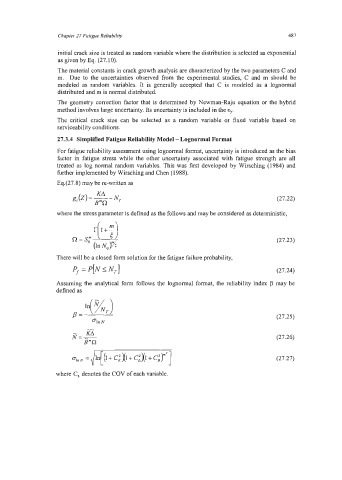Page 511 - Marine Structural Design
P. 511
Chapter 27 Fatigue Reliability 487
initial crack size is treated as random variable where the distribution is selected as exponential
as given by Eq. (27.10).
The material constants in crack growth analysis are characterized by the two parameters C and
m. Due to the uncertainties observed from the experimental studies, C and m should be
modeled as random variables. It is generally accepted that C is modeled as a lognormal
distributed and m is normal distributed.
The geometry correction factor that is determined by Newman-Raju equation or the hybrid
method involves large uncertainty. Its uncertainty is included in the E,,.
The critical crack size can be selected as a random variable or fixed variable based on
serviceability conditions.
27.3.4 Simplified Fatigue Reliability Model - Lognormal Format
For fatigue reliability assessment using lognormal format, uncertainty is introduced as the bias
factor in fatigue stress while the other uncertainty associated with fatigue strength are all
treated as log normal random variables. This was first developed by Wirsching (1984) and
hrther implemented by Wirsching and Chen (1988).
Eq.(27.8) may be re-written as
(27.22)
where the stress parameter is defined as the follows and may be considered as deterministic,
(27.23)
There will be a closed form solution for the fatigue failure probability,
Pf = P[N 5 NT] (27.24)
Assuming the analytical form follows the lognormal format, the reliability index p may be
defined as
(27.25)
Oh N
(27.26)
(27.27)
where C, denotes the COV of each variable.

